Portfolio: Vollis Simpson Whirligigs
- Time Machine
- North South Texaco
- Waving Bomber
- V. Simpson
- Tricycle Globe (with blue dome) and Waffle (right)
- Sawing Men (Saw Dog)
- Face Detail From Gunshot Bicycle Man
- The Field
- NC SC State Line, Foreground
- “V. Simpson” Suspened From Crane Over Low Boy Trailer Before Loading
- Simpson Repair Shop, Exterior
- Vollis Shop Interior With Casts of His Hands in The Background
- Plane from “V. Simpson”
- Work in Progress (foreground) and Guitar Man (background)
- Reflector Wheel
When I would sit and talk with Vollis Simpson at his repair shop, near Lucama, Wilson County, North Carolina, he would often voice his irritation about folks who littered and wasted. He railed against those who discarded bags of garbage, mattresses, tires, and other detritus in the woods and fields on his land, telling me about times he tracked down the culprits through what they left behind, went to their houses, and demanded they clean up the trash. One afternoon, when he was having trouble getting around, he had me stake a sign into the side of the dirt and gravel Vollis Shop Road, just behind a mattresses and box springs one of those rogues had thrown out the night before. The poster board sign lettered with marker said, “Sorry S.O.B. $200 Reward.” Sometimes Vollis would tell me about how farming had changed, how the land was ruined nowadays by farmers who insisted on plowing when it was too wet, making a mess of the fields. In the late summer and early fall he would tell me to go and glean the sweet potatoes that were left behind by farmers who rented his fields for their crops. Even when he had gone to his cane, Vollis would drive out into those fields and throw dozens of misshapen potatoes into the back of his pickup truck so he could give them away at his shop when folks came by to look at his whirligigs; every day he would put food scraps out on a covered picnic table he had designed and built so the animals—squirrels, raccoons, birds—would have something to eat throughout the day. Vollis would often voice strong opinions about most issues, and even though people knew that his whirligigs were created from scrapped objects, I was intrigued that many folks didn’t link his propensity to collect metal for sculptures with ideas like conservation and recycling.
From 1951 to the early 1980s Vollis Simpson’s repair shop was neat, clean, and in pretty tidy shape, but over the past thirty years the area around the shop became a collection of parts and objects he purchased from manufacturing plants, salvage yards, and a host of other businesses in and around Wilson County. It was open storage, an inventory that Vollis would draw from when he was building his kinetic sculptures that stretch out and up to gigantic proportions. If it could catch air, enable spinning, gleam, shine, twirl, or whirl, Vollis would check it out to see if he could use it to build a whirligig or windmill. Before he began building and erecting his sculptures along Wiggins Mill Road, he built a windmill while he was in the Army Air Corps in World War II. It was made to wash clothes on Saipan in the South Pacific. That war-built washing machine has often been cited in articles and stories about Vollis, but at times he ignored inquiries about the suds maker; instead, he would glow when he talked about the motorcycle he built as the war drew to a close. Even in his twenties, Vollis was creatively reusing scrapped and discarded items to build machines.
After the war ended and Vollis was back in Wilson County, he worked the farm he grew up on for a few years until he built a repair shop in 1951 on a sliver of land at a rural five-points intersection near his house. He based his business out of the shop for over 30 years, repairing equipment and machines, building tow trucks and cranes out of army surplus vehicles, spraying tobacco fields with a self-propelled sprayer he invented, doing rigging work, towing, salvaging, and moving buildings like his father did when Vollis was growing up. He had a shop, but often he had work that kept him laboring all over the county and region. I have heard many times from people around the area that if someone needed something done, towing, moving a house or barn, moving machinery into a manufacturing plant, and no one else could do it, Vollis Simpson could do it. He honed his natural abilities in mechanics and engineering over many years of hard work until he became a master craftsman. While he worked he continued to repurpose materials to create distinct machines for various tasks. When the heating oil shortages and corresponding spike in prices crippled the country in the early 1970s, Vollis built a windmill that forced wood-heated air through the ductwork of his house. Although there was a little issue with smoke leakage, his talent in reclaiming objects for new and kinetic uses saved him money and the frustrations of coping through shortages that dragged on through the rest of the 1970s. Vollis was a maker, a builder, a creator, an inventor, and his supplies were often whatever he had held onto that he bought from junk yards, salvage yards, and various manufacturing plants.
In the late 1970s and early 1980s, Vollis decreased his work load a bit, transitioning to a shorter work week, and he decided to fill the time by building a few windmills and kinetic sculptures using the metal and other materials he had around the shop and his house. When asked why he started building windmills, Vollis said, “I had a lot of material left over and I didn’t want to junk it or salvage it. I put most of it out there in the pasture.” At first he worked part-time, mostly weekends and down times, but even working just a few days a month, after about 10 years he built and erected around 20 separate pieces. The first piece he put up, out in front of his shop near the corner of Vollis Shop Road and Wiggins Mill Road, is striking because it isn’t a windmill or a whirligig. A collection of old car parts, unusual curved steel bars, steel bicycle rims, a metal globe, an arrow cut from barn roofing tin, and what looks to be a perforated washing machine tub are assembled, painted red, white, green, yellow, and blue, covered with round vehicle reflectors and cut up road signs, mounted on a vehicle hub and erected on a pole. The kinetic sculpture resembles the satellite Sputnik, albeit a vibrantly painted version that moves and spins in the lightest of winds. Although this first piece was a strikingly abstract sculpture, many of the other early pieces that Vollis made and mounted near the repair shop were figurative—men riding bicycles and unicycles, a man riding a cart whipping a mule whose legs move back and forth when the wind pushes a large steel farm wheel around and around, two men sawing a long with a crosscut saw while their dog stands behind them with tail wagging. A few planes and helicopters are scattered about, some small, made of wood or PVC pipe and attached to larger pieces; some planes are much bigger, resembling large bombers with wings constructed of painted sheet metal or a Goodyear sign with spinning propellers and landing gear extended for touchdown on the tarmac. Many of these early pieces are adorned with ducks, made of diamond plate steel or thick sheet metal, painted in green and red and accented with reflectors. One duck, attached to a form that resembles the deconstructed parts of an airplane, is enormous: with an eight-feet-long body and six-feet-long steel rotating wings, all covered in road signs cut in various shapes and patterns, a striking color palette during the day that sparkles and glows when reflecting the headlights of passing cars at night. In those early years Vollis lined six pieces up near the shop and scattered another fourteen or so pieces around a fence line that rims a pasture enclosing a small fishing pond.
Vollis’s work seemed to build toward an apex of two monumental pieces that lend voice to his skills as a mechanic and engineer, his honed use of recycled materials, and his prodigious talent as an artist. The first is a 4500-pound, 55-feet-long cacophonous assemblage of bicycle wheels, stainless steel sheet metal, HVAC fans, stainless steel stove pipe, planes turned from wooden sign posts, textile mill rollers, aluminum cups, school bus mirrors, a bicycle frame, circular roof vents, sheet metal, truck hubs, and road signs cut and shaped into stars, triangles, rectangles, and fan blades to cover every available surface. Unique among Vollis’s sculptures are the letters cut from white road signs and attached to a diamond grate frame spelling out in all capital letters his signature, V. SIMPSON. The piece has more than sixty-five moving parts, making it seem alive, perpetually moving and spinning as the arrow-shaped vane turns the massive German steel (with attached plaque in German) frame into the wind. Although none of the spinning fans create a secondary motion as a whirligig is defined, the sheer size and amount of clanging, twirling parts, and pieces attached to the frame is overwhelming to the senses. The complexity of the piece and its profile, which seems sparse and simple viewed from the side and maddeningly dense observed from the end, demands deep inspection to understand how the sculpture is even assembled. It is harder to understand (at least for me, and I knew Vollis) how one man could create something so amazing. The more I have thought about it, it’s no wonder that he signed the sculpture; if I had made something as brilliant as V. SIMPSON, I would have signed it, too.
When Vollis would talk about The Horses whirligig, he talked about how it was the only one of his pieces he had to have some help erecting out in the pasture. Because The Horses was so heavy, it needed a bigger pole than the other whirligigs, and the pole it was mounted on need to be deeper than all the other poles—fourteen feet deep. So instead of breaking out the hole digger with extensions attached, digging the hole by hand, pouring cement, and setting the pole into the ground like he did for all of the other pieces, Vollis hired a well digger and a crane to set the piece and had concrete poured around the pole to set the whirligig in place. This piece is special. It’s not the tallest, it doesn’t have the most moving parts, and it doesn’t have the biggest diameter wheel, but it stands out among all the other whirligigs Simpson made. It’s massive in overall size, with a front wheel that is striking for its demure color choice, white with relatively little adornment. Originally it had four large fans attached to the front wheel, but Vollis switched those fans out years after it had been in the field for a couple of dozen smaller HVAC fans, which he mounted on the wheel with rollers he bought in bulk from the salvage yard. But the front wheel and the fans attached are just a small part of this piece. Behind the wheel Vollis used an old cotton gin drive that he tweaked and modified to transfer the movement from the front wheel to the vane of the whirligig. But he didn’t construct a traditional wind-catching vane; instead, he assembled wheels, wood, metal, reflectors, and other parts and engineered them into a kinetic vane that instead of just turning the whirligig into the wind, turned the wind into a storyteller. The Horses consists of a team of mules (Vollis called them The Mules or The Horses; he made them as mules, although many saw them as horses) that simply pulls a wagon, although the engineering and mechanics that he put into the piece make it special. When the front wheel engages the drive, the drive moves the legs on each of the mules, while also wagging the mule ears. As the beasts walk forward, the wheels on the wagon spin and the man perched on his bench seat at the front of the wagon moves his arm in a motion that mimics the light whipping of the mule team, pushing them forward on their journey. The effect is such that the entire piece seems to be moving forward while stationary in the air. Adding to the effect is that for the secondary motion to take place, the big front wheel has to be spinning continually.
Even though the piece is complex, Vollis constructed it out of materials that are fairly straightforward. Instead of the cacophony of V. SIMPSON, there is a playful elegance about The Horses that is comforting. The piece isn’t abstract; it’s the opposite—more of grounding in time and place and how Vollis grew up, moving buildings with his father with a team of mules or working the farm when he was growing up. One day when I was out visiting Vollis, I heard about the significance of the piece and its placement at the back of the field near the pond from a couple of local guys. They had grown up in the area farming and were doing some work for Vollis, clearing brush around the pasture one afternoon as we began talking. Before long the conversation turned from idle chit chat to a discussion about the whirligigs, when one of the men started telling me about working on the farm with Vollis and his family. He said that The Horses brought back his childhood. When I asked what he meant, he said that when he was young that he had unloaded many a guano sack off a mule wagon at the same spot where Vollis had raised his sculpture. To him, that’s why Vollis made it and why he put The Horses in that spot, as a kind of memorial to those times years ago when farm work was more brute force and less mechanization. The story this man and his cousin told about The Horses really pushed me to think about Vollis’s whirligigs not just as sculptures that are abstract, figurative, or even historical. I started to see them as pieces of a puzzle that together tell a much greater story of people, land, and community.
Over the years many have referred to the pasture and the whirligigs contained within as Acid Park, a name that is connected to a local legend that says Vollis built the whirligigs, mounted them in the pasture, and covered them in reflectors because he was mourning the loss of a daughter to a car accident. The story told in myriad ways is rambling and fluid; many say the man was attempting to re-create the last trippy high of his daughter and her boyfriend, or maybe he was just trying to send a warning, bright and intense, so no one else would succumb to the hot rod curves of rural Wiggins Mill Road. Some broke it all down and said that Vollis himself was the one that was high, and crazy. If only it were so simple. I’ve always thought that Vollis was smarter than most folks and with his wealth of commonsense ability and technical skill, he creatively built what he could imagine and built it bigger than most folks could easily wrap their minds around. His daughter is alive, with kids of her own, and his sons are alive, and his wife, Jean, still lives in the house where Vollis was born.
Shortly after a day sitting and talking about Vollis’s experiences in World War II, I asked him if he traveled around much after he got back from Saipan. He laughed and told me that he did enough traveling in the war and didn’t see the need in doing much more when he got back home safe and sound. Even though he didn’t travel much anymore, I kept thinking that Vollis was one who seemed to carry everything with him all the time. He liked to joke around or just sit around and talk, and he could also be crotchety and gruff at times, but he was pretty soft underneath. Often our conversations would get to places that I hadn’t expected as things roamed around a bit. In some ways, that is what the whirligigs are for me. There is an element of whimsy in what Vollis built, a playful conversation that I think many people see in his work, and that playful conversation bares his soft side, which was a large part of who he was. But more and more, the whirligigs are for me that conversation that gets to a place I hadn’t expected, a depth to what he was making out of scrapped metal, fiberglass, wood, copper, aluminum . . . parts and pieces crafted and shaped and welded and painted, into a collection of stories, a long conversation. He seemed to carry everything with him and was open to learning (because everything might be important), and this seems similar to the parts of his process of making, creating, building art. Everything was there, even if he hadn’t seen it yet, whether it was an absurdly long and large steel pipe, dozens of spindles out of an old closed-up cotton mill, hundreds of HVAC fans in seemingly every possible size and shape, a big plastic hot pepper from a Chili’s restaurant, an old heating oil drum, a Federal WLR Fire Truck Siren, a 1930s Ford Wide Five Hub and Wheel, electro-plated nickel silver wine goblets, roofing tacks, threaded rod, milkshake cups. They all carried stories with them, but Vollis had the talent and skill to mold them into new shapes and forms to tell another story, a different story that revealed his life and what was inside him, as well as the life and culture of the community he was a part of. I think his work resonates with people partly because of that; with his sculptures, whirligigs, and windmills he revealed parts of himself and spoke a language that people understood.
On one of those warm spring afternoons that Vollis and I sat around at his repair shop, talking and nodding off in the middle of a conversation, he talked about how the rabbits that used to be all around the shop and the pond were scarce these days and he wished he had a rabbit that he could set loose out in the pasture. I told him that the garden at my house was steadily being devoured by little cottontails that hid out in the edge of the woods for cover. I asked him about building a rabbit box, and he told me to build the box out of some wide boards from an old barn because the rabbits could be lured and trapped easier in an old wood box than one crafted from new boards. I didn’t have any old boards that were wide enough and I didn’t want to go steal boards from somebody’s falling-down barn, so I made a rabbit box out of some new untreated pine boards. Well, the rabbits weren’t buying it. They would not be fooled into entering a nice cozy trap that smelled like fresh tree death and no food I put out for them—apples, pears, fresh lettuce (they were already eating my lettuce in the garden) or anything else—would entice them inside the box trap. I did catch a psycho squirrel who chewed through the screen and wood at the back to get out, but I didn’t even get a nibble from a bunny, big or small. It became a running joke between me and Vollis. I would drop by the shop and he would ask me if I had caught that rabbit yet, and then he would laugh and ask me what I had tried to get them to eat this time. After a few weeks, every time I went to see him he would look up from what he was working on, grin mischievously and say, “Oh, there’s Jeff Rabbit,” and laugh like a little kid. I felt like a failure, a little like I was disappointing him because I couldn’t catch him a bunny rabbit.
It became an obsession for me to trap at least one, and I realized that I had to do something about the box. Instead of making a new one, I took the one I made earlier, got some dirt, and rubbed it all over the inside and the outside of the box and put it back out for the rabbits. That night, as I lay sleeping in my bed, a nice little cottontail hopped into my rabbit box to snack on some sliced apples, bumped the trigger stick, and placed herself in solitary confinement. When I went out that morning and found the rabbit, I was grinning from ear to ear. I put the box in the car and drove directly to Vollis’s shop and waited for him to get there. He greeted me with “Jeff Rabbit,” but finally I had a counter. I pulled the box from the car, set it up on its end, and slid the wooden door back to reveal a cowering little bunny. That’s when Vollis, a ninety-two-year-old man, turned into a kid. He was thrilled, telling me to get the box while he slowly headed for his truck. We went over to the pasture between The Horses and the pond ,and while he tried to roust the rabbit from the comfortable confines of the pine box I held two cameras, taking pictures with one hand and video with the other. The rabbit, scared but safe, refused to come out although Vollis was rapping the side of the box with his cane. Finally, to get the rabbit to move along into the high grass at the edge of the pasture, Vollis tilted the box up, and the rabbit shot out of the box on a dead run before zigging and zagging into the weeds. Vollis and I both smiled really big as the rabbit settled into her new home. I was still “Jeff Rabbit” after that, but every time Vollis said it, he smiled and laughed in a different way, remembering the cottontail now out in his pasture.
The whole saga of the rabbit was further reinforcement of something that Vollis lived with his art and taught me more than once as a friend. Many times, the things that work best aren’t necessarily glossy new and shiny, but are instead a little older, worn and used a bit, but often get the job done better. I miss Vollis and those times we sat around and talked about life and windmills, but I still have him around every time we repair and conserve one of his older whirligigs, bringing them back to life and to his original intent so we can mount them in downtown Wilson when we open the Vollis Simpson Whirligig Park and Museum. When it opens, on the former site of one of Wilson’s old brick tobacco warehouses, I know that Vollis will live on through what he created and a new generation will learn about engineering, mechanics, physics, science, technology, and conservation through the art that he started making that day he decided to put all of that scrap material up in the pasture.
*All photographs and text by Jefferson Currie


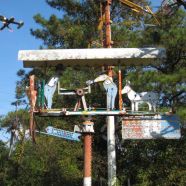





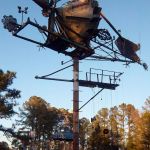
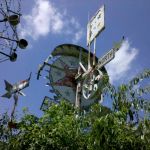
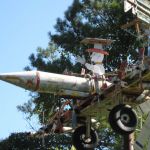
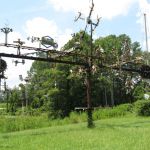
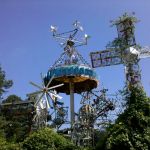
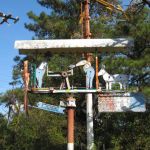
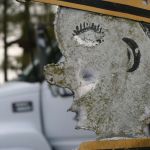
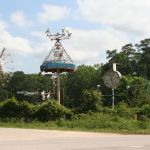
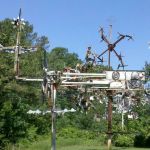
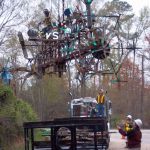
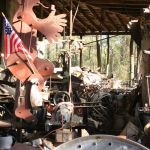
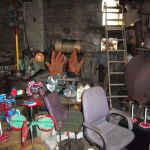
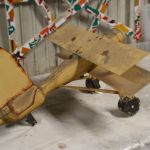
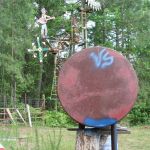
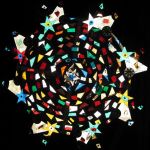
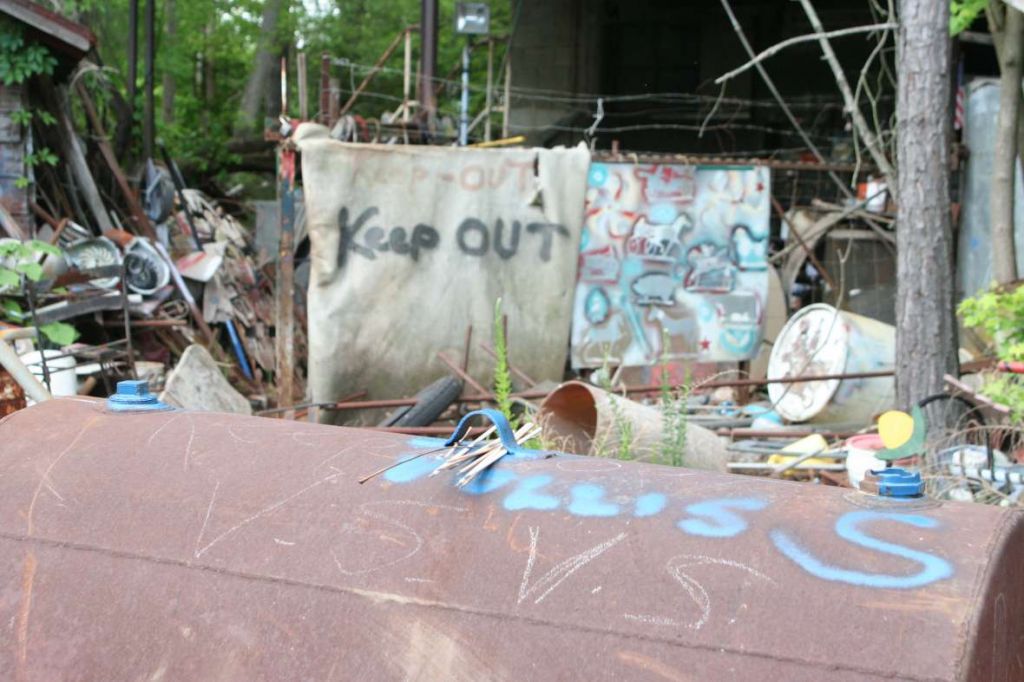
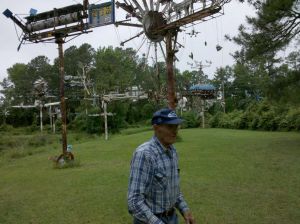
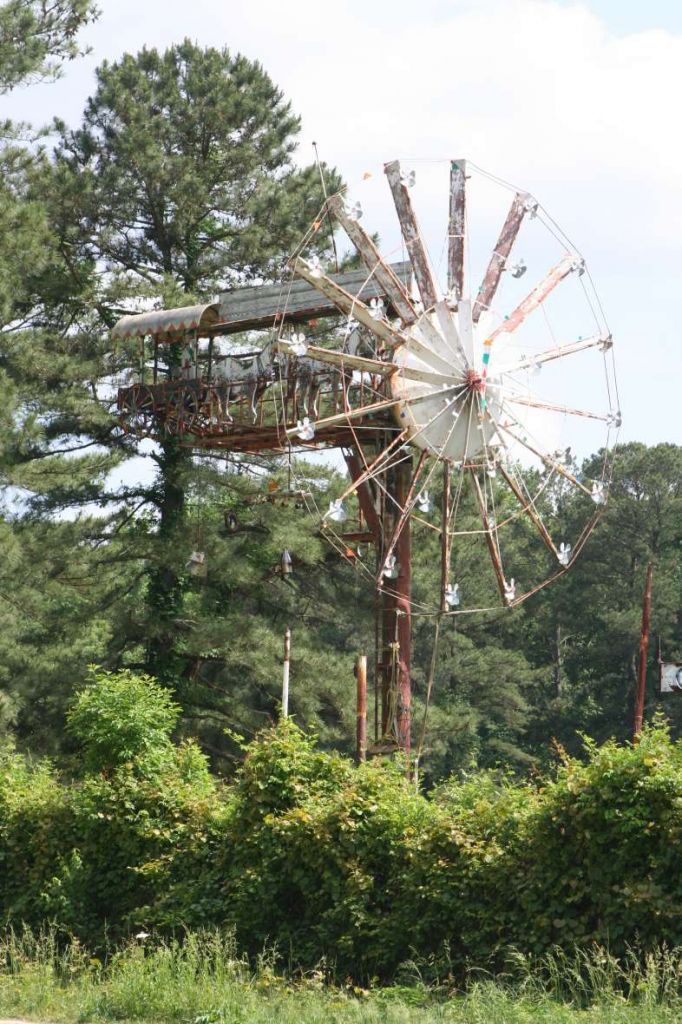
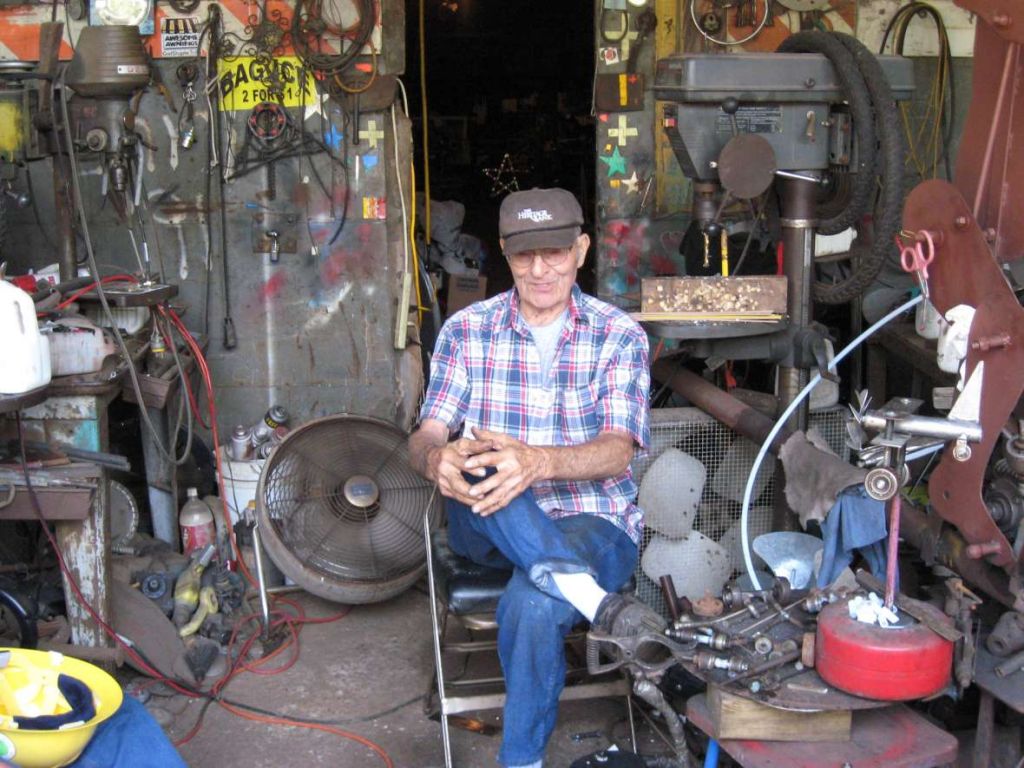
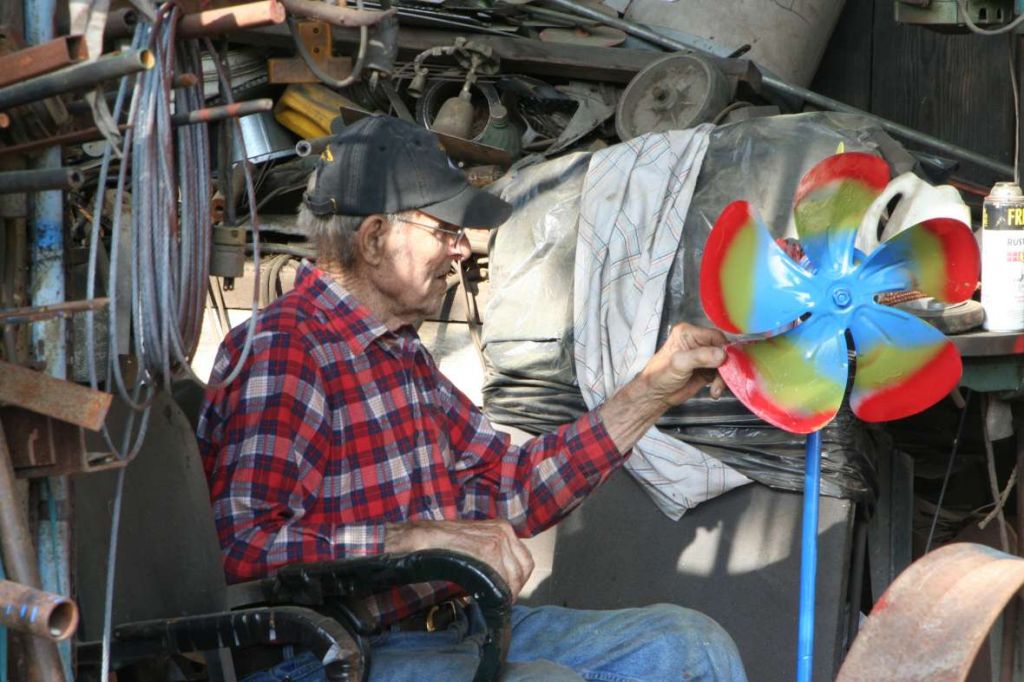
What a prolific writer you are! You paint many pictures with your words and that is what words are supposed to do! Thank you from another person who is in love with words….
Uncle Vollis was a hard worker we sure miss him.
the second time i visited with Mr Simpson, he was eating his lunch out in front of his workshop. he had opened a ripe pear and placed it nearby. he said so the yellow jackets could have something to eat, too. of course, the pear kept them away from his lunch.
he reminded me so much of my own daddy whose love was music, but both had the simplicity of natural men who held deep bonds with all the world’s creatures (one year thrashers ate all his spouted corn and his comment was, ” they have to eat, too.” and, Lordy, the stories they both told of those old days!
as slightly as i knew Vollis Simpson,it was a treasure of my life to have known both men.
I just adored Mr. Simpson and his sweet, lovely wife. I grew up not too far from where his farm is and when we talked, he knew my grandfather and grandmother and of many of my older relatives. He reminded me so, of my “PaPa” and I just loved hanging out with him. He almost always had a seat the Festival, but it was usually a bit out of the way, as he seemed to prefer. He seemed to never mind much about the hoopla of his engineering briliance; but he loved to talk about places and people nearby of which he knew and it gave he and I a bond besides the fact he knew I loved the work he did. He seemed to like having his creations to be called work rather than art. He was so unassuming about his talent and ability to make incredible structures out of surplus of one sort or another. I am saddened that he is gone, but he left behind an incredible collection of “work”/art that will live on for generation after generation. He is the type of celebrity I find it incredible to meet; one with personality, substance and character. I wear my WhirlyGig tee shirts everywhere! He, like his art, is special and unique!
Lovely article in both content and style. Makes me homesick just readin it _ in a good way, of course. Thanks for the stroll down memory lane.
Jeff, Daddy loved you so. He knew you understood him even across the generations. There have been some good and really perceptive things written about him and his motivations, but this is the best! Thank you for everything on behalf of myself and our family.
Barnie